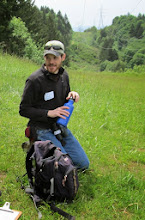Last night, I started watching the Super Bowl as a Pittsburgh Steelers fan, but by the end I was cheering for the the Arizona Cardinals because I was so impressed by the play of wide receiver Larry Fitzgerald.

Unfortunately for the Cardinals, the Steelers won a hard-fought battle by scoring a touchdown in the final minutes.

Arizona has a great mascot in the northern cardinal because the actual birds can be seen in much of the southern half of the state.

I distinctly remember my first encounter with a northern cardinal. It happened in the parking lot of Organ Pipe Cactus National Monument near the Mexican Border. My classmates and I had driven through the night from Montana for a field ecology course. We wearily exited our car and were greeted by a blazing red denizen of the desert.

I was excited to see the bird, though my friends from the east had seen plenty before and were not as impressed.
The Cardinals were one of the original NFL teams. They started up in Chicago and later moved to Saint Louis, both cities near the center of the northern cardinal's range. In 1988, the team moved to Arizona, keeping their mascot. I wonder if they would have changed mascots had they moved to California, as once planned, where northern cardinals rarely occur.
Recently, I looked at the range map of northern cardinals and noticed that they occur in Texas and southern Arizona, but skip over much of New Mexico. I gave this some thought and figured that their shunning of the Land of Enchantment must be a result of vegetation patterns, which determine the ranges of most landbirds.

In the east, Cardinals nest among tall deciduous shrubs and small trees near forest edges. Fragmentation of forests has therefore led to increases in cardinal populations throughout much of the country.
In Arizona, cardinals are found in Sonoran desert scrub habitat that contains small deciduous trees such as palo verde and ironwood, pictured above.

These trees do not exist in much of New Mexico, which is dominated by grasslands and short shrubs at low elevations, large cottonwood trees along rivers, pinyon pines and junipers at mid-elevations, and tall conifers at higher elevations. These vegetation types are not preferred nesting habitat of cardinals.
During the last century, however, small deciduous trees such as saltcedar and Russian olive were introduced from Europe and Asia and have spread throughout much of New Mexico, changing the composition of nesting habitats.

The consequences of this habitat change are mixed, depending on the bird species examined. Generalist, shrub-nesting species often respond well to high densities of exotic shrubs and trees. If Northern cardinals find these exotic habitats favorable, they may soon occupy a larger range in New Mexico.








3 comments:
I had 12 male northern cardinals at my feeders on Sunday and a flock (20 or so) Robins- it was crazy, they are stunning.
This was interesting about the cardinals. The Cardinal is the state bird of Indiana, where I live, so I see dozens of them every day. I have seen them in Tucson when I visit my sister, so they are spreading westward.
Very informative post. I have heard that the Cardinals resident in AZ have longer crests and inter-breed with Pyrrhuloxias. I also take issue with the Cardinals (football)insignia which is not color-correct as it depicts the Cardinal with a yellow beak instead of the natural red. However, I do realize they have used artistic license for greater visual impact.
Post a Comment